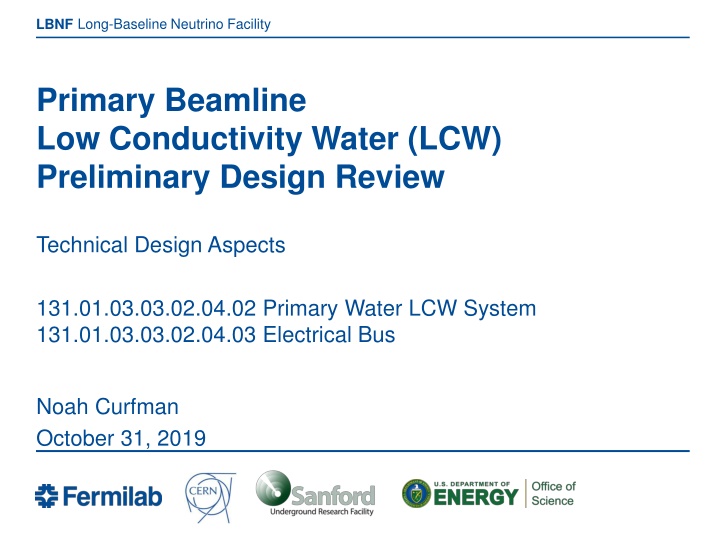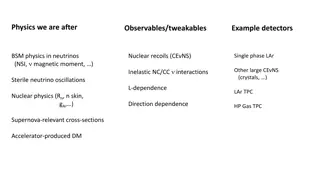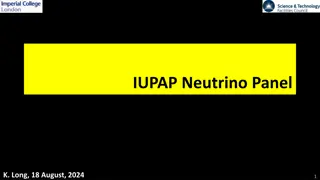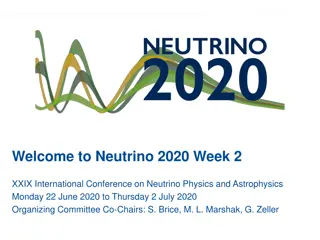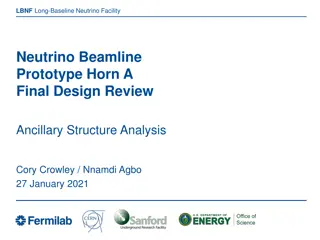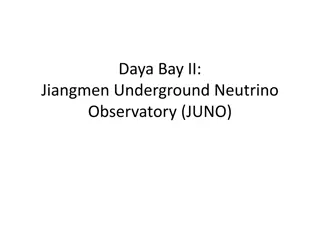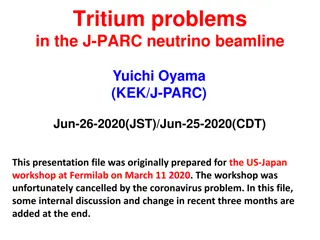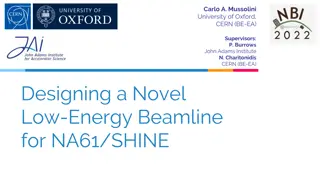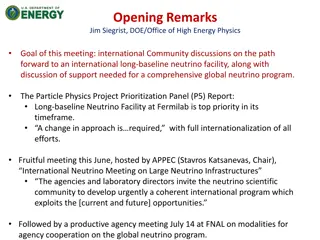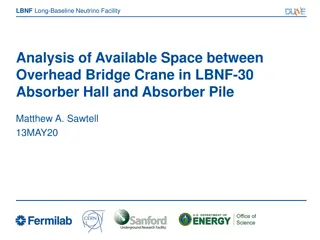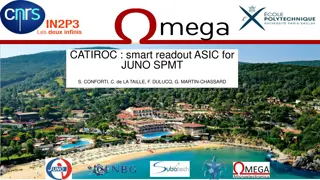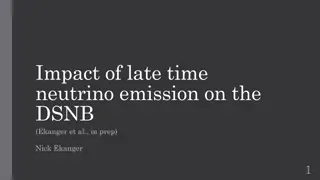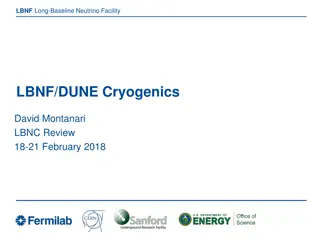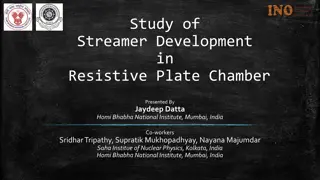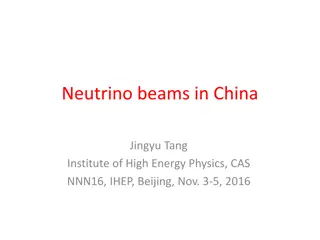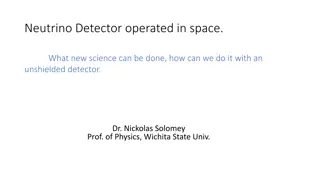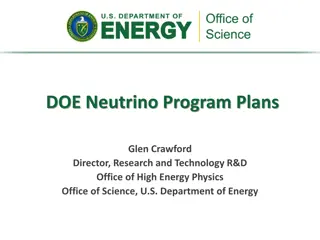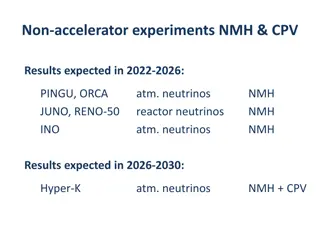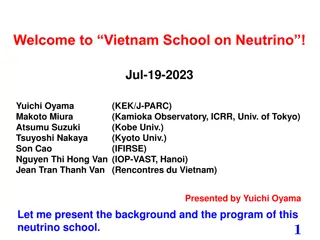Long-Baseline Neutrino Facility (LBNF) Primary Beamline LCW System Overview
The Long-Baseline Neutrino Facility (LBNF) Primary Beamline Low Conductivity Water (LCW) System comprises various technical design aspects including system operational scope, major system updates, design requirements, and component summary. It involves the provision of LCW cooling for magnets and power supplies, management of dipole bus routing and hydraulics, and adherence to established operational goals and lab practices. The system must operate efficiently while meeting specific criteria for fluid quality, temperature, pressure, and radioactivity levels. Components such as water-cooled magnets, power supplies, and bus systems play crucial roles in the functionality of the LCW system.
Download Presentation

Please find below an Image/Link to download the presentation.
The content on the website is provided AS IS for your information and personal use only. It may not be sold, licensed, or shared on other websites without obtaining consent from the author.If you encounter any issues during the download, it is possible that the publisher has removed the file from their server.
You are allowed to download the files provided on this website for personal or commercial use, subject to the condition that they are used lawfully. All files are the property of their respective owners.
The content on the website is provided AS IS for your information and personal use only. It may not be sold, licensed, or shared on other websites without obtaining consent from the author.
E N D
Presentation Transcript
Long-Baseline Neutrino Facility LBNF Primary Beamline Low Conductivity Water (LCW) Preliminary Design Review Technical Design Aspects 131.01.03.03.02.04.02 Primary Water LCW System 131.01.03.03.02.04.03 Electrical Bus Noah Curfman October 31, 2019
System Operational Scope Beamline Crest LBNF LCW Start Point LBNF - 5 Service Building LBNF - 20 Target Hall MI-10 Extraction Region Vehicle Access Tunnel Downstream Upstream 10.31.19 Noah Curfman | Primary Beamline LCW Preliminary Design Review 2 LBNF
Summary of Major System Updates Re-arrangement of service building MVA staging area merged with service building Re-arrangement of dipole power supplies - Significant changes to pipe and bus routing Minor magnet lattice re-arrangements LBNF LCW fill system from MI added System now uses one primary pump with one hot spare 10.31.19 Noah Curfman | Primary Beamline LCW Preliminary Design Review 3 LBNF
System Operational Scope Provide LCW cooling - LBNF magnets downstream of Q203 - LBNF magnet power supplies in LBNF 5 - Horn power supplies in LBNF 20 - Water cooled bus Manage dipole bus routing and hydraulics - System does not include cable-connected magnets - System does not include bus-to-magnet connections (flags) - Includes pump room bus shielding Provide LCW makeup for RAW room 10.31.19 Noah Curfman | Primary Beamline LCW Preliminary Design Review 4 LBNF
System Design Requirements Meet previously described operational goals Require minimal unscheduled interventions Meet established lab practices for flow and capacity Operate over a range of elevations determined by CF Use pond water for cooling and MI LCW for fill Conform to ASME B31.3 and FESHM 5031.1 Fluid Low Conductivity Water 9M cm or better 95 F < 1900 pCi/ml 200 psig Resistivity Nominal Temperature Radioactivity MAWP 10.31.19 Noah Curfman | Primary Beamline LCW Preliminary Design Review 5 LBNF
Component Summary 41 water cooled magnets 502 GPM, 477 kW 2 QQU - Q60 Quadrupoles 15 QQB - 3Q120 Quadrupoles 12 IDA Dipoles 12 IDD Dipoles 24 power supplies 228 GPM, 178 kW 15 quadrupole power supplies 7 dipole power supplies 2 horn power supplies 4,612 feet of 2 x2 dipole bus 95 GPM, 193 kW 5 pairs of bus 10.31.19 Noah Curfman | Primary Beamline LCW Preliminary Design Review 6 LBNF
Flow Requirements Flow Required 502 GPM Magnets Magnet Power Supplies Dipole Bus Horn Power Supplies Filtration Allowance RAW Room Fill 5% Contingency Estimated System Flow 128 GPM Sum of est. flows: 895 GPM 95 GPM 100 GPM With 5% contingency: 940 GPM 50 GPM 20 GPM - Horn PS flow may be over-estimated 45 GPM 940 GPM Fathom model: 124 BHP - 135 HP motor req. at 92% Efficiency 150 HP 900 GPM Flowserve Pump - 72% efficiency @ 908 GPM - 109.3% of BEP - 37.4 ft. NPSHA, 24.1 ft NPSHR 10.31.19 Noah Curfman | Primary Beamline LCW Preliminary Design Review 7 LBNF
Flow Requirements Magnet Type QQB - 3Q120 Quad QQU - 3Q60 Quad IDA Dipole IDD Dipole Required flow 6 GPM All magnets 100 psi dP or higher Using full dipole flows 8 GPM 15 GPM Only 2/3 may be required 18 GPM Detail view of magnets after beamline crest from PDF of Fathom Model Indicating Fluid Flows in DUNE DocDB Doc. #16706 10.31.19 Noah Curfman | Primary Beamline LCW Preliminary Design Review 8 LBNF
Fluid Velocity Pump Outlet Vehicle Access Headers Upstream Supply Header Downstream Supply Header Upstream RR Header Downstream RR Header 5.3 ft/s 6.4 ft/s 8.4 - 3.8 ft/s 5.9 - 2.3 ft/s 5.9 ft/s 8.4 ft/s Detail view of LCW supply piping at tunnel alcove from PDF of Fathom Model Indicating Fluid Velocities in DUNE DocDB Doc. #16706 10.31.19 Noah Curfman | Primary Beamline LCW Preliminary Design Review 9 LBNF
System Pressures Max system pressure MAWP 200 psig Expansion Tank Pump Inlet Pump Outlet Max Pressure 15 psig (N2) 2 psig 170 psig 178 psig Magnet dP Magnet PS dP Horn PS dP 109-140 psi Detail view of LCW supply piping at upstream end of tunnel from PDF of Fathom Model Indicating Fluid Pressures in DUNE DocDB Doc. #16706 60 psi 50 psi 10.31.19 Noah Curfman | Primary Beamline LCW Preliminary Design Review 10 LBNF
Heat Dissipation Dissipated Power 477 kW Magnets Magnet Power Supplies Dipole Bus Horn Power Supplies 10% Contingency Pump BkW to LCW Total kW Dissipated: Selected HX Size 103 kW 193 kW 60 kW Nominal fluid temp: 95 F 83 kW 97 kW 1,013 kW 1,200 kW Heat exchanger T: 9.1 F Magnets T: 1.4 F 11.5 F Pump Motor Heat Dissipation Pump Motor Horsepower: Pump Motor Power in kW: Pump Motor Efficiency: Heat Loss into Room (kW): 150 111.9 90% 11.2 Power supplies T: 0.9 F 9.1 F Dipole bus T: 7 F 22.8 F VFD Heat Dissipation Pump Motor VFD Horsepower: Pump Motor VFD Power in kW: Pump Motor VFD Efficiency: Heat Loss into Room (kW): 150 111.9 93% 7.8 Max fluid temp: 118 F Occurs in longest bus run Does not account for air cooling Total Heat Loss into Pump Room: 19 kW 10.31.19 Noah Curfman | Primary Beamline LCW Preliminary Design Review 11 LBNF
System Capacities Fluid Volume 2,721 Gal. 622 Gal. 538 Gal. 266 Gal. 195 Gal. 4,342 Gal. 1 2 3 4 5 Service Building & Pipes to Tunnel Magnets Upstream of Service Building Magnets Downstream of Service Building Before Crest Magnets Downstream of Service Building After Crest Target Hall and Piping Leading to Target Hall Total System Volume: 1 5 4 3 2 10.31.19 Noah Curfman | Primary Beamline LCW Preliminary Design Review 12 LBNF
ASME B31.3/FESHM 5031.1 Compliance 8 straight pipe @ 200 psig trequired= 0.054 6 curved access corridor pipes @ 200 psig trequired = 0.041 8 sch. 10 304/304L pipe tactual = 0.138 , 2.5x thicker than required 6 sch. 10 304/304L pipe tactual = 0.134 , 3.2x thicker than required Only listed tees, junctions, valves, etc. will be used - Class 150 Flanges are sufficient 10.31.19 Noah Curfman | Primary Beamline LCW Preliminary Design Review 13 LBNF
System Design Requirements Meet previously described operational goals Require minimal unscheduled interventions Meet established lab standards for flow and capacity Operate over a range of elevations determined by CF Use pond water for cooling and MI LCW for fill Conform to ASME B31.3 and FESHM 5031.1 Fluid Low Conductivity Water 9M cm or better 95 F < 1900 pCi/ml 200 psig Resistivity Nominal Temperature Radioactivity MAWP 10.31.19 Noah Curfman | Primary Beamline LCW Preliminary Design Review 14 LBNF
